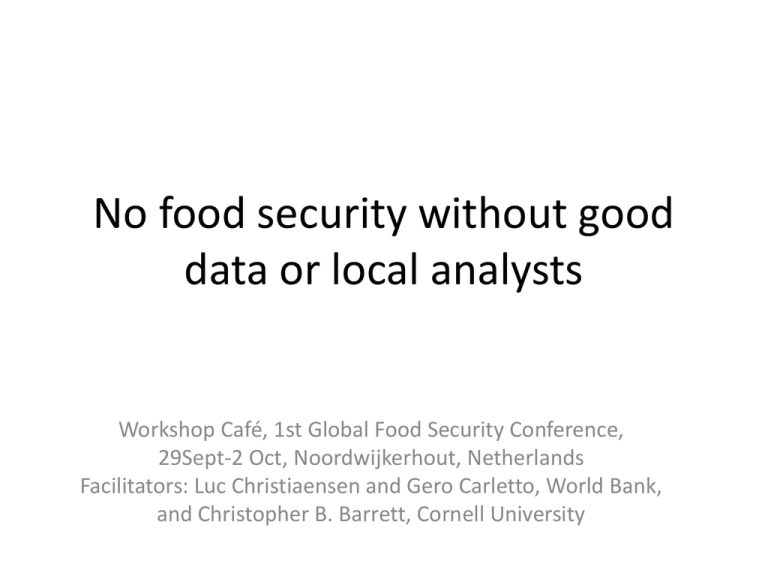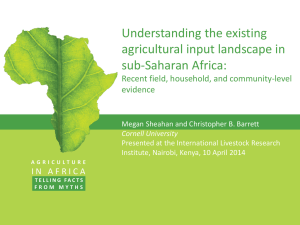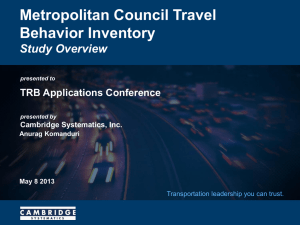No food security without good data or local
advertisement

No food security without good data or local analysts Workshop Café, 1st Global Food Security Conference, 29Sept-2 Oct, Noordwijkerhout, Netherlands Facilitators: Luc Christiaensen and Gero Carletto, World Bank, and Christopher B. Barrett, Cornell University Points of departure • The Grand Challenge – Statistics and capacity to measure and analyze food security remain wanting (especially in SSA) • Several initiatives … – LSMS-ISA – one attempt to address the void • Much more needed brainstorm to prioritize Africa’s statistical challenge • Of 44 SSA countries reviewed by FAO, only 2 have high standards in data collection • As of last year, 15 countries in SSA did not have a household expenditure survey within the last 5 yrss and a survey @ 5 yrs prior to that. • And if they do, poor comparability/inconsistent estimates • Slow to introduce best practices, new technologies • Insufficient documentation & dissemination when survey data do exist • Limited capacity to analyze data Three questions • What data to collect? • How to improve data quality? • How to maximize its use and impact? What data to collect (1)? • Issues in measuring and analyzing food security – Thematic: availability, access, utilization , stability – Spatial: global … national … individual – Temporal: acute … chronic • Evolving emphasis … – From availability (Borlaugh) to access (Sen), back to availability (&utilitization/nutrition) – From global to individual back to global/national What data to collect (2)? • On the one hand, a plethora of data and instruments – – – – – Agricultural sample surveys, Censuses Household consumption surveys (HBS, IES, LSMS, HIS) Health/nutrition surveys (DHS, MICS) Welfare Monitoring Surveys (WMS) Nutrition surveys (24-hour) – Comprehensive Food Security Vulnerability Assessments (CFSVA) In addition to: – Administrative price data – Georeferenced data (satellite/NDVI, roads, weather) Scope for re-purposing and “convergence” What data to collect (3)? • On the other hand, some failure to … 1. integrate across • topics (within the instruments – lsms-isa) • time (areas/sentinels, households, individuals) 2. differentiate across • • Individuals/groups plots 3. provide sufficient periodicity • high frequency data 4. capture uncertainty/risk/resilience • Static versus dynamic indicators 5. address new data demands • • • • climate change post harvest loss nutrition sensitive agriculture … What data to collect (4)? • And part of the solution lies in optimizing the use of existing data: – Integrate data across space • • geo-referencing concentrate on same sampling areas – Integrate across data instruments • poverty mapping (census and household surveys) – Integrate across time • Food security forecasting (HICS and WMS) • … but also new and better data necessary! Improving the availability, relevance, and quality of household survey data for policy and research in Sub-Saharan Africa Working on 4 fronts • Collecting household survey data with focus on agriculture in 8 SSA countries • Improving methodologies in data collection, producing best practice guidelines & research • Documenting & disseminating micro data, policy research • Building capacity in national institutions Survey features • • • • Nationally representative (rural and urban) Multi-topic and disaggregated Linked with ecosystems data 1-3 year panels of individuals • Data Entry: from centralized to field-based • Open data access policy • Collaborative: done with NSOs Survey instruments Household • Individual-level data on demographics, education, health, labor & anthro • Housing, durable assets • Food & non-food consumption • Income • Food security • Non-Farm enterprises • Subjective welfare Agriculture • Plot-level data on (i) Land Areas, (ii) Labor & nonlabor inputs, (iii) Crop cultivation & production • Crop sales & utilization • Farm implements • Extension services • Livestock • Fisheries Community • • • • • • • Demographics Services Facilities Infrastructure Governance Organizations & groups Market prices Survey Schedule Tanzania Uganda Malawi Nigeria 2008/09 2010/11 2009/10 2010/11 2012/13 2011/12 2010/11 2013/14 2013 2012/13 2010/11 Mali 2014/15 Ethiopia 2011/12 Niger 2011/12 Burkina 2011/12 2013/14 2014/15 2014/15 Partnerships are key • • • • • • • • • In-country co-funding USAID: Mali WFP: Food security IFAD: Community governance, gender WFC: Fishery FAO/ILRI/ARD: Livestock FAO: Global Strategy FAO/IFPRI: Analysis CMAAE: Training What data to collect (5)? • And many challenges remain – Periodicity • LSMS-ISA only every 1-3 years – Coverage • LSMS-ISA only in 8 countries and only in Africa – Harmonization versus customization • Local vs global use (different items, different importance ) • Comparability over time and space • Inertia, acceptance, capacity building – Poor quality, low credibility How to improve data quality • Methods matter! Importance of validation … – Consumption: Food (recall, diary, reference periods) – Production: Land area Measurement (GPS vs. selfreported) • Role of technology – CAPI, GPS, mobile phones, … • Institutional set up – Coordination/ harmonization over time and x-country, mandate, incentives, … Lack of standards results in poor comparability! • Take Food Consumption … – Diary vs. recall – Household vs. individual – Reference period – Nomenclature (COICOP) – Bulk purchases – Non-standard units of measure – Food consumed away from home (FAFH) – Valuation of consumed own-production Take the reference period of food consumption … 100 90 80 70.0 70 P e r c e n t 60 50 41.0 40 30 24.0 23.0 20 10 5.0 7.0 0 Less than one week One week Two weeks One month Greater than one month Less than or equal to two weeks • Implications for comparability overtime and x-country • What’s the “truth”? Measuring Farm Productivity • Many different measures, similar issues! • Take land productivity (yield) Measuring production – the numerator • Farmers don’t keep records • Cassava harvested in small quantities over several months • Recall widely used, but does not always work • Measured in non-standard units of varying size • Different units along the value chain, different states • What are the alternatives? How to choose? – Need validation! In pictures … Quantifying non-standard units … Now the denominator – land area What are the different methods? • Satellite imagery • Lots of potential but . . . • “Eye estimate” • Surprisingly widespread but … • Traversing (compass and rope) • Gold standard but … • Farmer’s self-reporting • Widely used but … • GPS • Increasingly used but … Does using GPS make a difference? Source: 2005/06 UNHS Source: Carletto, Savastano, Zezza (2013). “Facts or Artifacts: the Impact of Measurement Errors on the Farm size - Productivity Relationship”, Journal of Development Economics. … which, in terms of yields ... Farm Size (terciles) Yields difference (GPS-SR)/GPS Smaller Cv cv 28% Medium 7% Larger Source: 2005/06 UNHS -30% Cvc v But, is Uganda a special case? Yields differences: (GPS-SR)/GPS FARM SIZE (terciles) Pooled Malawi Uganda Tanzania Niger Smaller 19.4% 18.0% 17.4% 32.2% 19.1% Medium -4.3% -5.7% -4.1% -0.1% -3.3% Larger -19.1% -13.9% -34.0% -28.5% -89.6% How to maximize its use and impact? • Awareness of and access to data – one stop shop portal? – – – – Meta data Raw data (LSMS-ISA) Processed data (RIGA, CLSP, Myths and Facts) Linked secondary data (LSMS-ISA) • Training versus learning by doing – – – – – Technical assistance (to LSMS-ISA statistical offices) Mentorship program AERC model (sponsor LSMS-ISA use by individual researchers) CMAAE (regional M.S. training program) Funding doctoral training (Centers of Excellence, OECD universities, regional universities) http://www.worldbank.org/lsms-isa http://www.worldbank.org/lsms-isa How to maximize its use and impact (2)? • A practical example – Agriculture in Africa – Telling Facts from Myths • Leading the way – Include other, similar data sets (Ghana, Zambia, Mozambique) – Inducing others to replicate LSMS-ISA (Central Africa, West Africa) • Disseminating results for impact – Publications – Briefs for media and policymakers Objectives • Solid, updated, bottom up picture of Africa’s agriculture, food security and its farmers livelihoods AG R I C U LT U R E IN AFRICA T E L L I N G FA C T S FROM MYTHS • Harmonized, easy to use database of core agricultural and food security variables for tabulation and regional cross-country benchmarking • Community of practice. COMMON WISDOMS REVISITED 1) Use of modern inputs remains dismally low 2) Land, labor and capital markets remain largely incomplete 3) Agricultural labor productivity is low 4) Land is abundant and land markets are poorly developed 5) Access to credit remains low 6) Extension services are poor 7) Agroforestry is gaining traction 8) African agriculture is intensifying 9) Women perform the bulk of Africa’s agricultural tasks 10) Seasonality continues to permeate rural livelihoods 11) Smallholder market participation remains limited 12) Post harvest losses are large 13) Droughts dominate Africa’s risk environment 14) African farmers are increasingly diversifying their incomes 15) Agricultural commercialization and diversification improves nutritional outcomes Page 33 MENTORSHIP PROGRAM A G R I C U LT U R E I N A F R I C A T E L L I N G FA C T S FROM MYTHS 1. Abidoye Babatunde (Nigeria) 2. Fuje Habtamu (Ethiopia) 3. Gandonou Esaie (Benin) 4. Kasirye Ibrahim (Uganda) 5. Kinuthia Bethuel (Kenya) 6. Liverpool-Tasie Lenis (Sierra Leone) 7. Ndiaye Moctar (Senegal) 8. Ngenzebuke Rama Lionel (Burundi) 9. Ogunyemi Oluwole (Nigeria) 10.Owoo Nkechi (Ghana) As a global community … • What data collection to promote? How to better integrate data? • What instruments to promote? How to foster the creation of standards? • What institutional set ups to promote? How to improve coordination?








